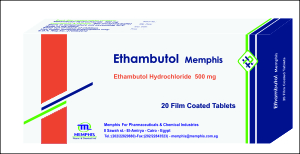ETHAMBUTOL Memphis Ethambutol hydrochloride 500 mg Film-coated tablet 1. NAME OF THE MEDICINAL PRODUCT ETHAMBUTOL Memphis 500 mg film-coated tablet 2. QUALITATIVE AND QUANTITATIVE COMPOSITION Ethambutol hydrochloride................................................................................................. 500 mg For a film-coated tablet For the full list of excipients, see section 6.1. 3. PHARMACEUTICAL FORM White, round, biconvex film-coated tablet. 4. CLINICAL DATA 4.1. Therapeutic indications • Curative treatment of active pulmonary or extrapulmonary tuberculosis. • Treatment of symptomatic primary tuberculosis infection. • Chemoprophylaxis: Ethambutol may be used for chemoprophylaxis in case of contraindication to the use of antituberculosis drugs recognized for this indication. In this case, ethambutol should always be used in combination with a major antituberculosis drug. • Treatment of infections with sensitive atypical mycobacteria (sensitivity determined by MIC). This treatment is based on a combination of active antibiotics. 4.2. Dosage and method of administration General rules for the treatment of tuberculosis. Curative treatment of tuberculosis must comply with the following main rules: • A well-conducted and well-monitored treatment is, with the lasting negative results of bacteriological tests, the essential criterion for cure. • Treatment should only be administered after bacteriological proof of tuberculosis. Bacteriological examination systematically includes direct examination, culture and antibiogram. However, if there is an emergency or if the lesions are typical and the bacilloscopy is negative despite its repetition, treatment can be instituted and will be reconsidered when the culture is available. • Effective treatment must: o Combine 3 anti-tuberculosis drugs (attack treatment) until the results of the antibiogram and for at least two months to avoid the emergence of resistance, then two anti-tuberculosis drugs (maintenance treatment). o Combine 4 anti-tuberculosis drugs in case of history of treated tuberculosis or relapse. o The attack phase can be continued for up to 3 months if the antibiogram result is not available. o Use the most active anti-tuberculosis drugs (bactericidal at effective doses, but adapted to avoid any overdose). o Be administered in a single daily dose, continuously and for at least 6 months in the case of initial triple or quadruple therapy of two months including at least rifampicin and pyrazinamide; 9 months in the case of initial triple therapy of two months not including these two antibiotics. Dosage The usual dose is: Adult: 15 to 20 mg/kg/day. It can be increased to 25 mg/kg/day: or in case of relapse, or in case of resistance of Koch's bacillus to other antibiotics. This dose should only be prescribed for a short period (less than or equal to 2 months) depending on the indications and requires increased monitoring of the patient (see section 4.4 Precautions for use).
